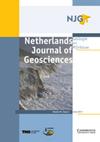Influence of Quaternary glaciations on subsurface temperatures, pore pressures, rock properties and petroleum systems in the onshore northeastern Netherlands
IF 2.3
2区 地球科学
Q3 GEOSCIENCES, MULTIDISCIPLINARY
Netherlands Journal of Geosciences-Geologie En Mijnbouw
Pub Date : 2022-05-12
DOI:10.1017/njg.2022.6
引用次数: 1
Abstract
Abstract Pleistocene glacial stages were implemented into a 3D basin and petroleum systems model of the northeastern Netherlands to address the influence of low surface temperatures and the mechanical loading of ice sheets on the subsurface. Two ice sheet thickness scenarios were used based on published data. Overall, Quaternary glacial stages have a substantial impact on the temperature and pressure distribution in the subsurface. Subsurface temperatures are significantly reduced during glacial stages, leading to lowered present-day temperatures and a low geothermal gradient in the shallow subsurface. In deeply buried sedimentary formations, pressures build up with every glacial advance resulting in overpressures at the present day. Glacial stages do not directly influence the petroleum generation of petroleum source rocks in the area, but high pressures during loading might have impacted petroleum expulsion of the early mature Coevorden Formation. Hydrocarbon accumulations in the Lower Saxony Basin were simulated to investigate the possible effects of mechanical ice loading and unloading on hydrocarbon migration. A loss of Coevorden Formation-sourced hydrocarbons to the surface was calculated in the Lower Saxony Basin during the glacial stages, indicating an influence of glacial loading on the Mesozoic petroleum system.第四纪冰川对荷兰东北部陆地地下温度、孔隙压力、岩石性质和石油系统的影响
为解决地表低温和冰盖机械载荷对地下的影响,将荷兰东北部地区更新世冰川期次模拟到三维盆地和油气系统模型中。根据已公布的数据使用了两种冰盖厚度情景。总体而言,第四纪冰期对地下温度和压力分布具有重要影响。在冰期,地下温度显著降低,导致当前温度降低,地下浅层地热梯度低。在深埋的沉积层中,压力随着每次冰川推进而增加,导致了今天的超压。冰期不直接影响本区烃源岩的生烃,但加载过程中的高压可能影响了早成熟Coevorden组的排油。通过对下萨克森州盆地的油气成藏进行模拟,探讨冰的机械装卸对油气运移的可能影响。计算了下萨克森州盆地冰期Coevorden组烃源岩向地表的损失,表明了冰川负荷对中生代油气系统的影响。
本文章由计算机程序翻译,如有差异,请以英文原文为准。
求助全文
约1分钟内获得全文
求助全文
来源期刊
CiteScore
4.00
自引率
25.90%
发文量
14
审稿时长
>12 weeks
期刊介绍:
Netherlands Journal of Geosciences - Geologie en Mijnbouw is a fully open access journal which publishes papers on all aspects of geoscience, providing they are of international interest and quality. As the official publication of the ''Netherlands Journal of Geosciences'' Foundation the journal publishes new and significant research in geosciences with a regional focus on the Netherlands, the North Sea region and relevant adjacent areas. A wide range of topics within the geosciences are covered in the journal, including "geology, physical geography, geophyics, (geo-)archeology, paleontology, hydro(geo)logy, hydrocarbon exploration, modelling and visualisation."
The journal is a continuation of Geologie and Mijnbouw (published by the Royal Geological and Mining Society of the Netherlands, KNGMG) and Mededelingen Nederlands Instituut voor Toegepaste Geowetenschappen (published by TNO Geological Survey of the Netherlands). The journal is published in full colour.

 求助内容:
求助内容: 应助结果提醒方式:
应助结果提醒方式:


